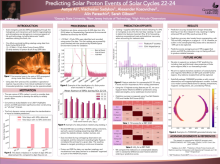Predicting Solar Energetic Particle Events & Understanding Their Relation to Dynamic Coronal Features
Aatiya
Ali
Georgia State University
Poster
Solar Energetic Particle (SEP) events and their major subclass, Solar Proton Events (SPEs; defined by stark increases in proton flux with energies >=10 MeV), and their propagation through the heliosphere and interactions with the Earth’s atmosphere result in unfavorable consequences to numerous aspects of life and technology. Given the rare nature of these events, it is crucial to study data from the Sun at different solar cycles to develop the ability to reliably forecast them.
In this work we report the completion of a catalog of > 10 MeV > 10 pfu SPEs observed by GOES satellites/detectors with records of their statistical properties spanning through Solar Cycles 22-24. We report an additional catalog consisting of daily proton and SXR flux statistical properties for extending the SPE prediction effort presented by Sadykov et al. (2021). Using these catalogs, we discuss the application of machine learning using a Support Vector Machine for prediction of SPEs across these solar cycles. We emphasize effects of cycle-to-cycle differences in event statistics and feature importance. Further, by considering MHD models of the solar corona, we investigate the relevance of plasma conditions in regions of CME generation to the production of SPEs. We also discuss future work combining FORWARD emission modeling and uCOMP observations.
In this work we report the completion of a catalog of > 10 MeV > 10 pfu SPEs observed by GOES satellites/detectors with records of their statistical properties spanning through Solar Cycles 22-24. We report an additional catalog consisting of daily proton and SXR flux statistical properties for extending the SPE prediction effort presented by Sadykov et al. (2021). Using these catalogs, we discuss the application of machine learning using a Support Vector Machine for prediction of SPEs across these solar cycles. We emphasize effects of cycle-to-cycle differences in event statistics and feature importance. Further, by considering MHD models of the solar corona, we investigate the relevance of plasma conditions in regions of CME generation to the production of SPEs. We also discuss future work combining FORWARD emission modeling and uCOMP observations.

Poster PDF
Poster category
Solar and Interplanetary Research and Applications
Meeting homepage